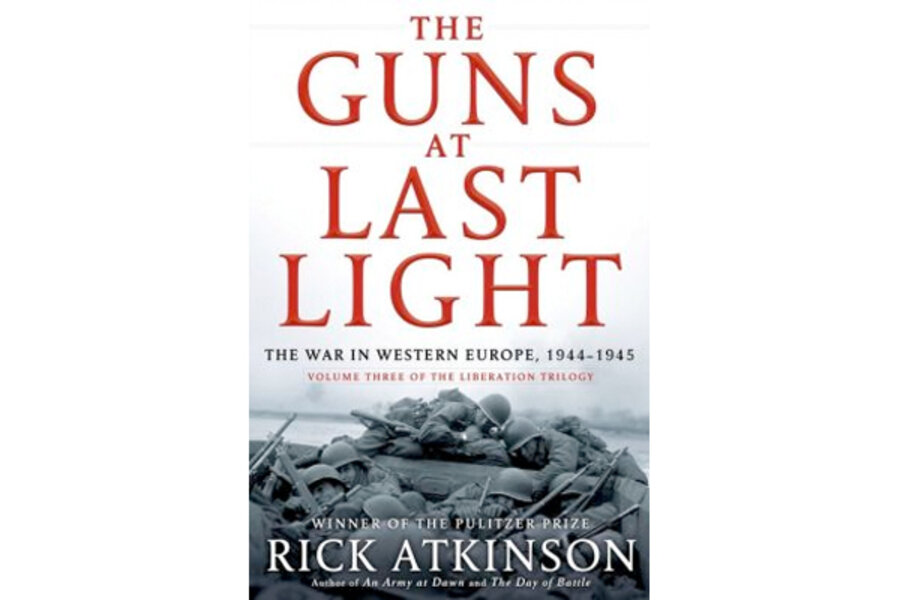The Guns at Last Light
Loading...
Journalist Rick Atkinson has spent the last 15 years writing the history of the American army in the European theater during World War II. The result is a three-volume series called “The Liberation Trilogy.” In “An Army at Dawn,” he described the invasion of North Africa and won a Pulitzer Prize. “The Day of Battle” focuses on the war in Sicily and Italy. With The Guns at Last Light, Atkinson brings the project to a close by analyzing the war in western Europe from D-Day to VE Day.
This is a well-ploughed field. A number of first-rate historians – Cornelius Ryan, Steven Ambrose, Martin Gilbert, Max Hastings, and Anthony Beevor all come to mind – have examined individual battles or the entire European campaign in detail. And, given all that has been written before, it’s reasonable to ask whether an additional book can shed much new light on this topic. Atkinson’s latest volume answers that question affirmatively and decisively.
The basic story is familiar: The complex and bloody invasion in Normandy and the difficulty of fighting through the hedgerows. Operation Dragoon and the invasion of southern France. The disastrous effort to capture a bridge over the Rhine at Arnhem. The brutal and bloody fighting in the Hurtgen Forest. The Battle of the Bulge. Jumping the Rhine at Remagen and, ultimately, Germany’s swift collapse.
As with the earlier volumes, “The Guns at Last Light” moves seamlessly between broad issues of strategies and the tactics employed by Allied and German armies and the fighting as experienced by individual soldiers. No military history can succeed unless the author clearly describes how the battles were planned and executed and the impact each engagement had on the broader conflict. Aided by a large number of exceptionally clear and detailed maps, Atkinson does this exceptionally well.
But it’s not just the battles that matter. For example, Atkinson underscores the importance of logistics and supply. By late 1944, the Allies had largely won the Battle of the Atlantic and could move men and equipment across the ocean with ease. But they had exceptional difficulty getting the ships unloaded and getting the materiel to the troops in a timely fashion. These delays often disrupted military plans. For the Germans, the issue was largely oil – they couldn’t get enough of it to adequately fuel their armored divisions and they too were forced to design battle plans around supply chains. More than once, readers will be reminded of the old aphorism that “logistics win wars.”
The role of airpower is another central theme. When the skies were clear, Allied forces had a powerful advantage. But when weather made flying impossible, Germans troops had great freedom of movement. Atkinson does not oversell the benefits of airpower – calling it “a blunt instrument, a bludgeon rather than a scalpel” – and he underscores the terrible impact of indiscriminate bombing on civilians. But he makes the reader well aware that control of the air was an extraordinary asset for the allies.
Ultimately, two things make this a riveting book. The first is the great emphasis that Atkinson gives to contemporaneous accounts such as diaries, letters, and unpublished manuscripts and the light this sheds on the thoughts and experiences of those who lived, fought, and often died in these battles. As a result, even at a remove of almost 70 years, the reader has some small idea of what it must have been like to fight on the front lines.
There are compelling stories and anecdotes from soldiers on both sides. As a result, all the emotions the soldiers felt – everything from omnipresent fear to occasional pleasures and even boredom – are conveyed with brutal simplicity. He notes that the life expectancy of a Luftwaffe pilot was measured “in weeks if not hours” and quotes a letter from one airman which read, “Each time I close the canopy before take-off, I feel that I am closing the lid on my own coffin.” On the other hand, writing about American soldiers on leave in Paris, he quotes one writing to his wife that the city “...was wonderful but I slept on the floor because the bed was just too much like sleeping in butter.”
Violence and death were omnipresent and soldiers became inured to it. A British soldier wrote home, “The question of killing does not present itself as a moral problem any more – or as a problem at all.” An American soldier tells his parents “Killing is an obsession.” An American general whose only son was killed in fighting stood at the open grave and said “So long, son" and then added, ‘Well, he is not cold and wet and hungry.”
The second factor that sets this book apart is the combination of extensive research and superb writing. Simply put, few historians have Atkinson’s gift for language and few journalists pay as much attention to historical sources. The book has more than 150 pages of detailed footnotes and sources that provide an extraordinary level of detail and insight. At the same time, Atkinson writes with the descriptive and lyrical power of a first-rate novelist. The prologue and epilogue alone are worth the price of the book.
Rare will be the reader who is not moved by Atkinson’s powerful and moving prose in this compelling story.
Terry Hartle is senior vice president of government relations for the American Council on Education.






